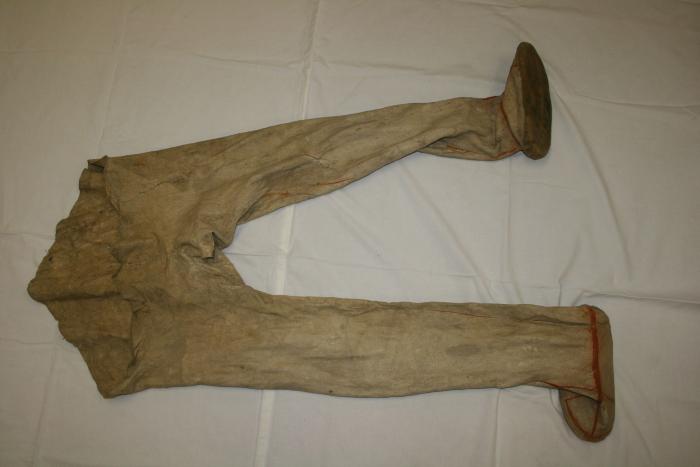Leather pants
William Smith (Contributor)
Brandon Moonin (Contributor)
Dawn Randazzo (Contributor)
Tatianna Turner (Contributor)
Vincent Evans (Contributor)
John F.C. Johnson (Contributor)
Deborah McMullen (Contributor)
Pamela Smith (Contributor)
Brandon Moonin (Contributor)
Dawn Randazzo (Contributor)
Tatianna Turner (Contributor)
Vincent Evans (Contributor)
John F.C. Johnson (Contributor)
Deborah McMullen (Contributor)
Pamela Smith (Contributor)
Hauke: Red paint
Brandon Moonin: Perhaps Eyak
William Smith: Looks older than the other pair of pants. ( ID Number: IV A 6519); since it does not have buttons.
Jens Matuschek: There is a hole in the crotch of the pants. Jens commented that this might have been for exhibition purposes.
William Smith: Doesn't think it is waterproof; since the material would soak up water quite quick.
William Smith: Sometimes use a binding at the seams, the red line could be connected to that or drawn for the cutouts to make the pants.
William Smith: Probably deerhide.
Dawn Randazzo: With waterproof stitching you can't see it on the outside but usually only in the inside. The pattern shows that they widened the pants. The pattern shows that there is a diamond shape used. Maybe it was used with a belt or some kind of suspenders.
Tatianna Turner: The pattern used at the feet for the stitching is different on these pants than the others.
Dawn Randazzo: You can only tell a waterproof stitch on the inside because it is sewn inside out.
Vince Evans: mukluk seal (for durability)
William Smith: Stitching is very small and close. Considering the needles that were used at the time. It must have taken a long time to sewn. Could have used porcupine or bone needles.
John Johnson: Sometimes when people didn't have enough to eat they would boil these type of clothes and make a soup.
Pamela Smith: Speculates; could be Carabou. The pants might not be from the Chugach region.
Deborah McMullen: My mom was a sewer. My mom and my sister both were. When I think about all the women that are sewer nowadays. If you watch women that sew now; you can see they put as much detail as the women did in those days. I can picture them. Piecing together that eagle parka.
John Johnson: Both men and women sew.
Brandon Moonin: Perhaps Eyak
William Smith: Looks older than the other pair of pants. ( ID Number: IV A 6519); since it does not have buttons.
Jens Matuschek: There is a hole in the crotch of the pants. Jens commented that this might have been for exhibition purposes.
William Smith: Doesn't think it is waterproof; since the material would soak up water quite quick.
William Smith: Sometimes use a binding at the seams, the red line could be connected to that or drawn for the cutouts to make the pants.
William Smith: Probably deerhide.
Dawn Randazzo: With waterproof stitching you can't see it on the outside but usually only in the inside. The pattern shows that they widened the pants. The pattern shows that there is a diamond shape used. Maybe it was used with a belt or some kind of suspenders.
Tatianna Turner: The pattern used at the feet for the stitching is different on these pants than the others.
Dawn Randazzo: You can only tell a waterproof stitch on the inside because it is sewn inside out.
Vince Evans: mukluk seal (for durability)
William Smith: Stitching is very small and close. Considering the needles that were used at the time. It must have taken a long time to sewn. Could have used porcupine or bone needles.
John Johnson: Sometimes when people didn't have enough to eat they would boil these type of clothes and make a soup.
Pamela Smith: Speculates; could be Carabou. The pants might not be from the Chugach region.
Deborah McMullen: My mom was a sewer. My mom and my sister both were. When I think about all the women that are sewer nowadays. If you watch women that sew now; you can see they put as much detail as the women did in those days. I can picture them. Piecing together that eagle parka.
John Johnson: Both men and women sew.
Do you have a story to contribute or a comment about this item?
Login/register to comment 